Acer Aspire 5 Slim Laptop, 15.6 inches Full HD IPS Display
Acer Aspire 5 Slim Laptop, 15.6 inches Full HD IPS Display
There are two types of laptops I've come to expect from Acer: Standout premium models like the crazy Swift 7 ultraportable and Predator Triton 900, and mainstream laptops that are impossibly good deals -- like last year's Predator Helios 300 and this year's Acer Aspire 5. For more than a year, Acer's Aspire E 15 was my go-to pick for anyone who just needed a quick, reliable laptop for general use around the home. Sadly, that model is getting harder to find, but the Aspire 5 is an excellent alternative that's thinner, lighter and still an impossibly good deal.
8.0
Acer Aspire 5 (2019)
CNET may get a commission from these offers.
LIKE
Thin and less than 4 pounds
Good overall port assortment
Easy to upgrade storage and memory
Good performance and battery life for the money
DON'T LIKEBuild quality is in line with its budget price
No SD card slot
, the 15.6-inch Aspire 5 is only 3.8 pounds (1.7 kg) and 0.7 inch thick (18 mm). That combination of size, weight and price, isn't easy to find with a 15.6-inch display. By comparison, the Acer E 15 had the same screen size, but was more than 5 pounds (2.4 kg) and just over an inch thick (30 mm). It also started at roughly the same price and was similarly configured. You do lose things like an SD card reader, a VGA display output and a DVD drive, but chances are it's only the card reader that matters to more people at this point, if anything.
, bumps that base model's processor from a dual-core Intel Core i3 to a quad-core i5, and doubles the memory to 8GB and storage to 256GB -- well worth the extra money. , you can get it with a new 10th-gen Core i5, entry-level Nvidia MX250 discrete graphics and a 512GB PCIe NVMe SSD. That's a lot of performance for everything from day-to-day basics to simple photo and video editing to gaming on low to medium settings.
Acer Aspire 5 (A515-54-51DJ)

Price as reviewed
|
$530
|
Display size/resolution
|
15.6-inch 1,920 x 1,080 display
|
CPU
|
1.6GHz Intel Core i5-8265U
|
PC Memory
|
8GB DDR4 2667MHz
|
Graphics
|
128MB Intel UHD Graphics 620
|
Storage
|
256GB SSD
|
Networking
|
802.11ac Wi-Fi wireless; Bluetooth 5.0
|
Operating system
|
Windows 10 Home (64-bit)
|
All the performance, none of the glory
Like any budget-friendly laptop worth its salt, Acer puts most of your money toward good internal components and not into things like an all-metal chassis or an ultrabright high-res touchscreen. For example, my Aspire 5 had a similar configuration to Lenovo's premium Yoga C930 two-in-one. Performance is about the same between the two but the Yoga is twice the price. What's more, you can pop the Aspire's bottom off and add more memory or increase storage on your own, something fewer and fewer premium models will let you do.
The Acer is mostly plastic, though it's capped with a thin sheet of aluminum to class it up a bit. Unfortunately mine ended up with a slight dent at the top of the display, which also made it a little too easy to peel the bezel off from around the screen (it snaps right back into place). That's not likely to happen on a pricier model, but hey, it does make the Aspire more serviceable at least. My point is, the build quality is fine for what you're paying, but don't expect the durability of a premium laptop.
No SD card slot, but plenty of other connection options. Sarah Tew/CNET
Around the sides you'll find several ports that are disappearing and being replaced with USB-C ports on other models. While there is one USB-C, it isn't Thunderbolt 3, but a USB 3.1 Gen 1 port. You'll also find:
Two USB 3.0 ports and a USB 2.0 port
HDMI output
Gigabit Ethernet
Combo headphone-mic jack
With this setup, you could easily load it up with a full-size keyboard and mouse, an external display and other essentials to use this as a desktop replacement. That's not to say the keyboard, touchpad and display need to be replaced -- they're fine, all things considered -- just that it can handle life on a desk as well as unplugged around the house. It has battery life to back it up, too, hitting 8 hours, 38 minutes on our streaming video test.
The full-HD IPS display has pleasing color and brightness, it looks fine off-angle and the matte finish helps tame distracting reflections. The backlit keyboard feels a little soft, but the keys have a decent pop to them and enough travel so you don't feel like you're typing on a tabletop (or a MacBook). The Windows Precision touchpad works well, too, and you even get a fingerprint reader built into it. Still, you might want to adjust the touchpad sensitivity to prevent your palm from accidentally moving the cursor.
Acer's Aspire 5 delivers premium appeal at a low price
18 PHOTOS
Another budget-friendly winner
The Acer Aspire 5 is a 15.6-inch thin-and-light that definitely delivers more performance for your money than you might expect. Though it starts low, the configuration I tested is a comfortable middle ground that's full-featured enough for typical work, home and school tasks. But even if you decide to go all out on upgrades, this model doesn't break the mark and you'll get a workhorse laptop that won't win any beauty contests, but should last you well into the future.
Geekbench 4 (multicore)
Samsung Notebook 9 Pro
LG gram 14
Lenovo Yoga C930
Acer Aspire 5
Apple MacBook Air (13-inch, 2018)
NOTE:
Longer bars indicate better performanceCinebench R15 CPU (multicore)
Lenovo Yoga C930
Acer Aspire 5
Samsung Notebook 9 Pro
LG gram 14
Apple MacBook Air (13-inch, 2018)
NOTE:
Longer bars indicate better performanceVideo playback battery drain test (Streaming)
LG gram 14
Samsung Notebook 9 Pro
Lenovo Yoga C930
Apple MacBook Air (13-inch, 2018)
Acer Aspire 5
NOTE:
Longer bars indicate better performance (in minutes)
System
configurations
Acer Aspire 5
|
Microsoft Windows 10 Home (64-bit);
1.6GHz Intel Core i5-8265U; 8GB DDR4 SDRAM 2,667MHz; 128MB (dedicated) Intel
UHD Graphics 620; 256GB SSD
|
LG gram 14
|
Microsoft Windows 10
Home (64-bit); 1.8GHz Intel Core i7-8565U; 16GB DDR4 SDRAM 2,400MHz; 128MB
(dedicated) Intel HD Graphics 620; 512GB SSD
|
Samsung Notebook 9 Pro
|
Microsoft Windows 10 Home (64-bit);
1.8GHz Intel Core i7-8565U; 8GB DDR4 SDRAM 2,133MHz; 128MB (dedicated) Intel
HD Graphics 620; 256GB SSD
|
Lenovo Yoga C930
|
Microsoft Windows 10 Home (64-bit);
1.8GHz Intel Core i7-8550U; 12GB DDR4 SDRAM 2,133MHz; 128MB (dedicated) Intel
HD Graphics 620; 256GB SSD
|
Apple MacBook Air (13-inch, 2018)
|
Apple MacOS Mojave 10.14; 1.6GHz
Intel Core i5-8210Y; 8GB DDR3 SDRAM 2,133MHz; 1,536MB Intel UHD Graphics 617;
256GB SSD
|
If you’re looking for an inexpensive quad-core laptop that’s less than three-quarters of an inch thick, the Acer Aspire 5 A515-54-51DJ might fit the bill. This slim laptop packs in more than enough power for everyday computing tasks, and its quad-core performance is respectable, if shy of awe-inspiring. A fingerprint reader and nearly all-day battery life will appeal to productivity-minded road warriors, although they’ll have to settle for a display that’s on the dim side.
Acer packs a bewildering number of configurations into its budget Aspire 5 line—at least 22 by my count, ranging from(at presstime) for a dual-core AMD Ryzen 3 3200U-powered model with a bare-bones 4GB of RAM and a 128GB solid-state drive, all the way to a considerably beefier quad-core Core i7-8565 model with a hefty 12GB of RAM, a 512GB SSD, and dedicated Nvidia GeForce MX250 graphics that at the time of this writing. Most Aspire 5 versions boast a 15.6-inch display (although I spotted at least one 14-inch model), with a mix of 1080p and 720p resolutions.
The configuration we’re reviewing here is a middle-of-the-road model, complete with a quad-core Core i5-8265U CPU, a Whiskey Lake processor that debuted in late 2018 as a modest upgrade (mainly a slightly faster boost clock speed) to 2017’s Core i5-8250U Kaby Lake Refresh chip. Comparable to a Core i7 processor from a couple of generations prior, the i5-8265U is a solid workhorse that can hold its own when it comes to CPU-intensive tasks like video editing.
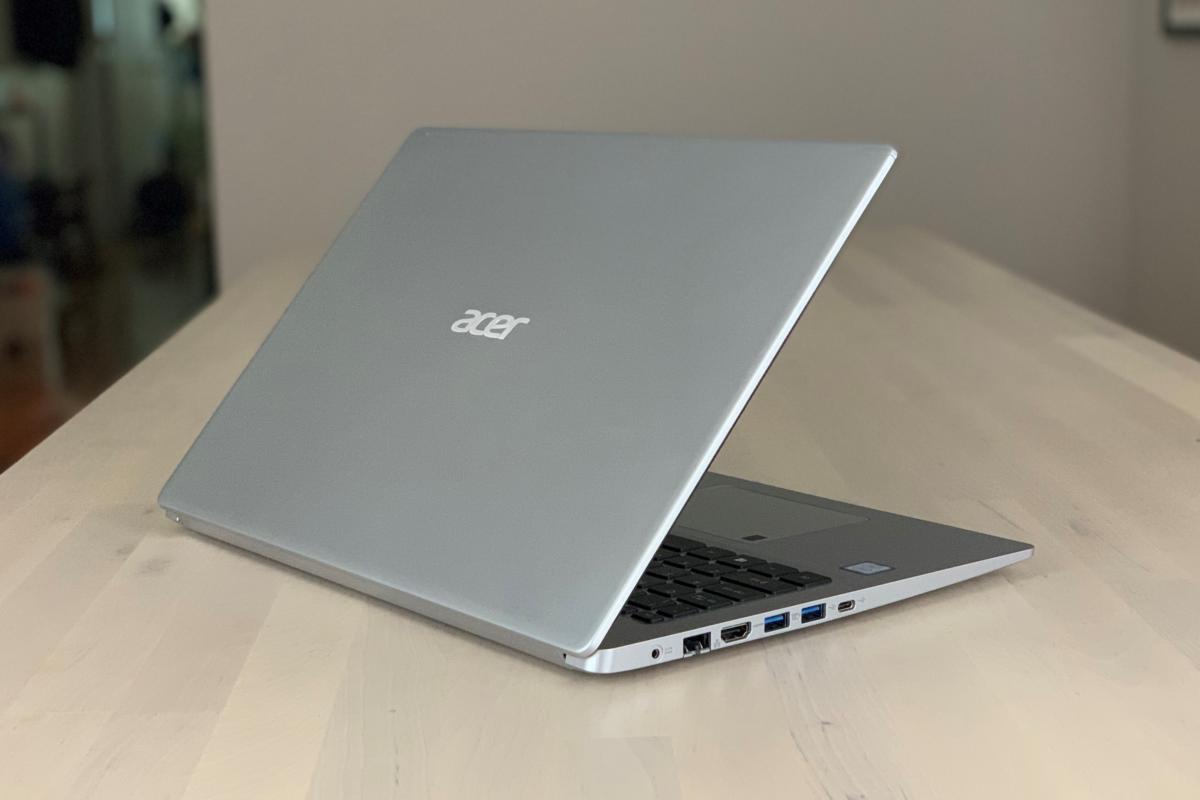
Also on board: a reasonable 8GB of RAM, which helps to smooth out performance when running multiple programs at once; a 256GB SSD, a decent amount of storage for a speedy solid-state drive; an integrated Intel UHD Graphics 620 chip, and a full-HD (1920x1080) 15.6-inch display.
On paper, that all adds up to a relatively sturdy workhorse for everyday computing chores like web browsing and composing Office documents, Intel’s integrated UHD 620 will let you do a little light gaming, but think Minesweeper more than Fortnite.
If you’d prefer to spend a little less money, check out our review of this Aspire 5 with a dual-core Core i3 processor, which lacks the Core i5’s quad-core power but still packs a punch when it comes to day-to-day desktop tasks.
Design
The laptops in Acer’s Aspire 5 line do a nice job of feeling thinner and lighter than they really are. This particular model of the Aspire 5 is no different: Yes, it tips the scales at nearly 4.25 pounds, but at just 0.7 inches thin the Aspire 5 manages to feel reasonably light, particularly given its sizable 14.3-by-9.9-inch footprint.
The laptop’s slim aluminum lid and tapered shell make it look fairly stylish for a budget laptop. Opening the lid reveals the 15.6-inch display with svelte left and right bezels, a dapper “Aspire” logo along the laptop hinge, and a silver-colored chassis offset by the black keyboard. Incidentally, the lid bends way back slightly beyond 180 degrees, which means you can lay the Aspire completely flat with the lid open.
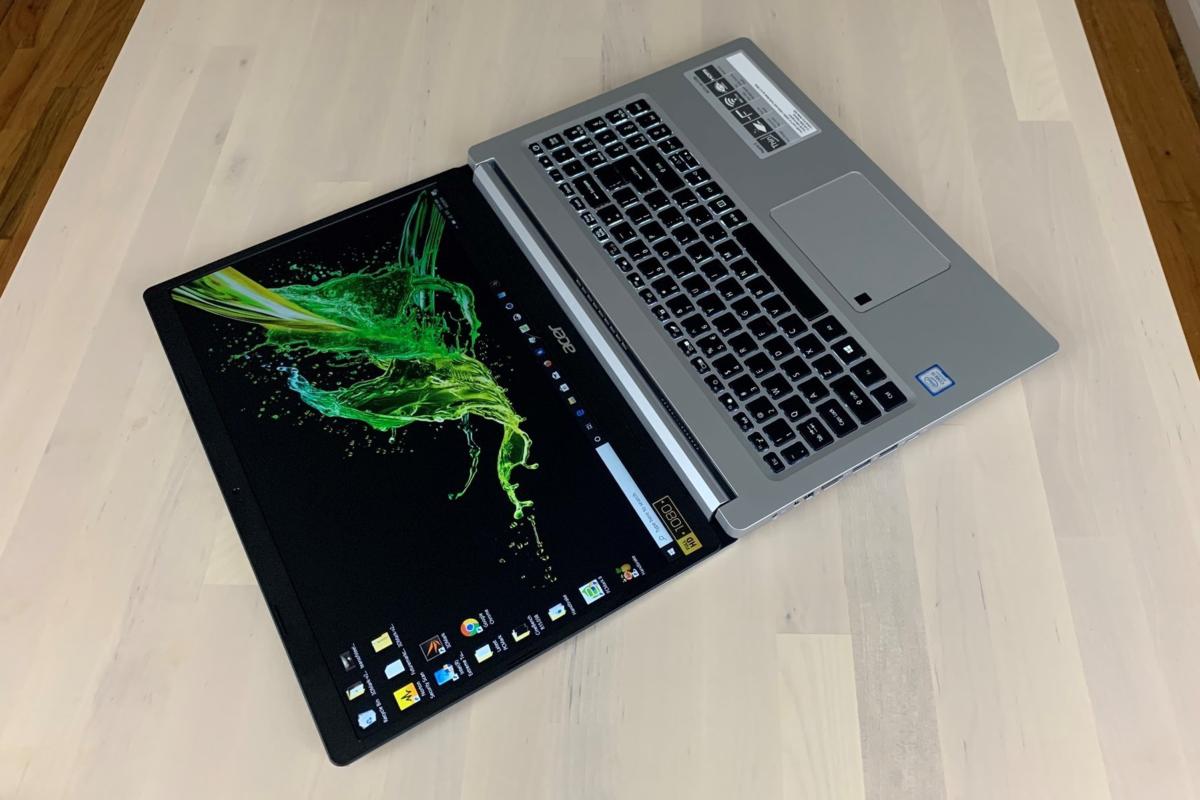
Turning the Aspire 5 upside-down, we find a pair of small speaker grilles near the front and a large cooling vent near the back. There are also 11 Phillips-head screws that look as though they’re inviting you to remove the bottom panel, and what’s this: an extra hard drive bracket? Alas, while you probably could go ahead and pop off the bottom panel, a note in the box warns that cracking open the chassis yourself could void the warranty, so you might want to leave the upgrades to an authorized service dealer.

Display
When it comes to the Aspire’s display, let’s start with the positives. Its 1920x1080 resolution is the minimum we like to see when dealing with a 15.6-inch screen. The Aspire’s IPS (in-plane switching) panel makes for solid viewing angles, with the display looking relatively bright and readable even when looking from the side, above, or below
. The display’s matted “ComfyView” design minimizes glare, though direct outdoor sunlight will fight back hard.
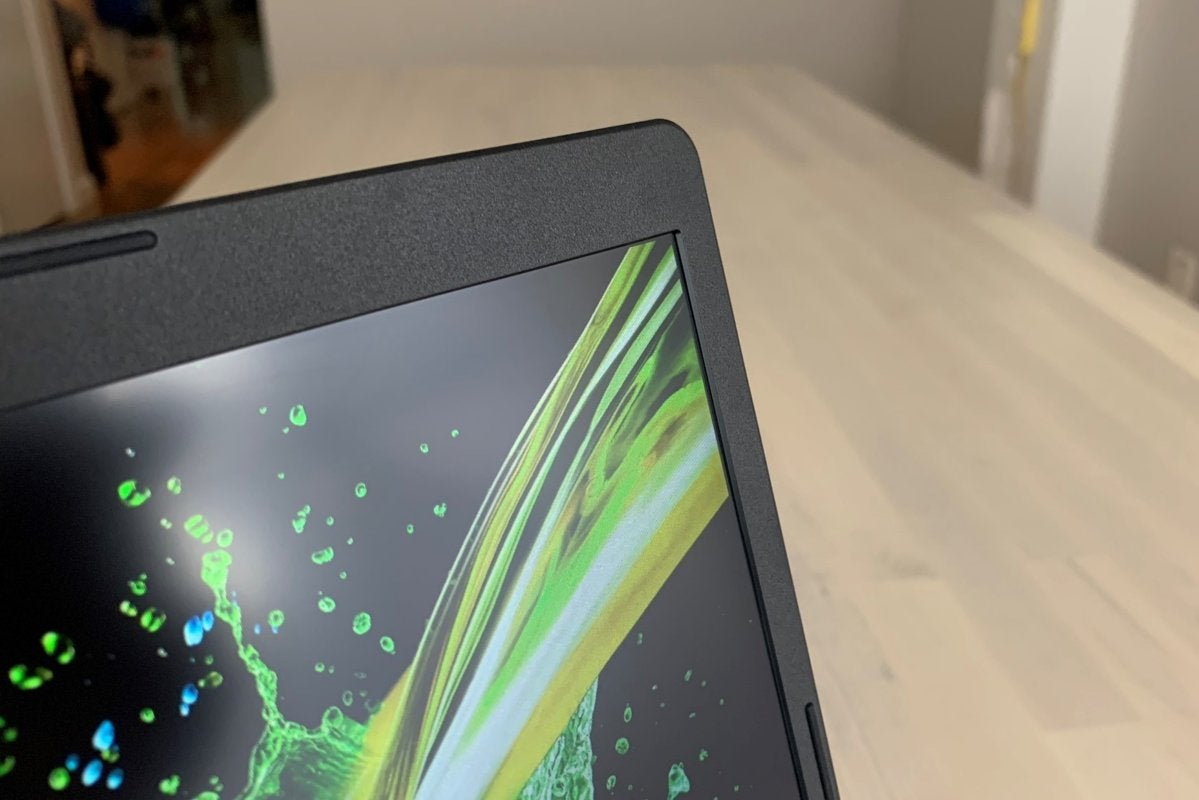
Unfortunately, the display on this particular model of the Aspire 5 is disappointingly dim—just 201 nits (or candelas) according to our measurements, which is well below the 250 nits we generally prefer. While the Aspire 5’s screen looked bright enough indoors, it began to fade noticeably when I was using it outside in the shade, and it looked even worse in direct sunlight.
Keyboard, trackpad, speakers, and extras
The Aspire 5 offers a roomy backlit keyboard complete with a 10-key numeric keypad. The latter is a tad too squished for our liking, but it’s there. The keys themselves felt good to type on, delivering a satisfying bump and springy rebound on each keystroke. That said, travel (basically a measure of how far the key travels on each stroke) felt a bit skimpy compared to other productivity-minded laptops I’ve tested.
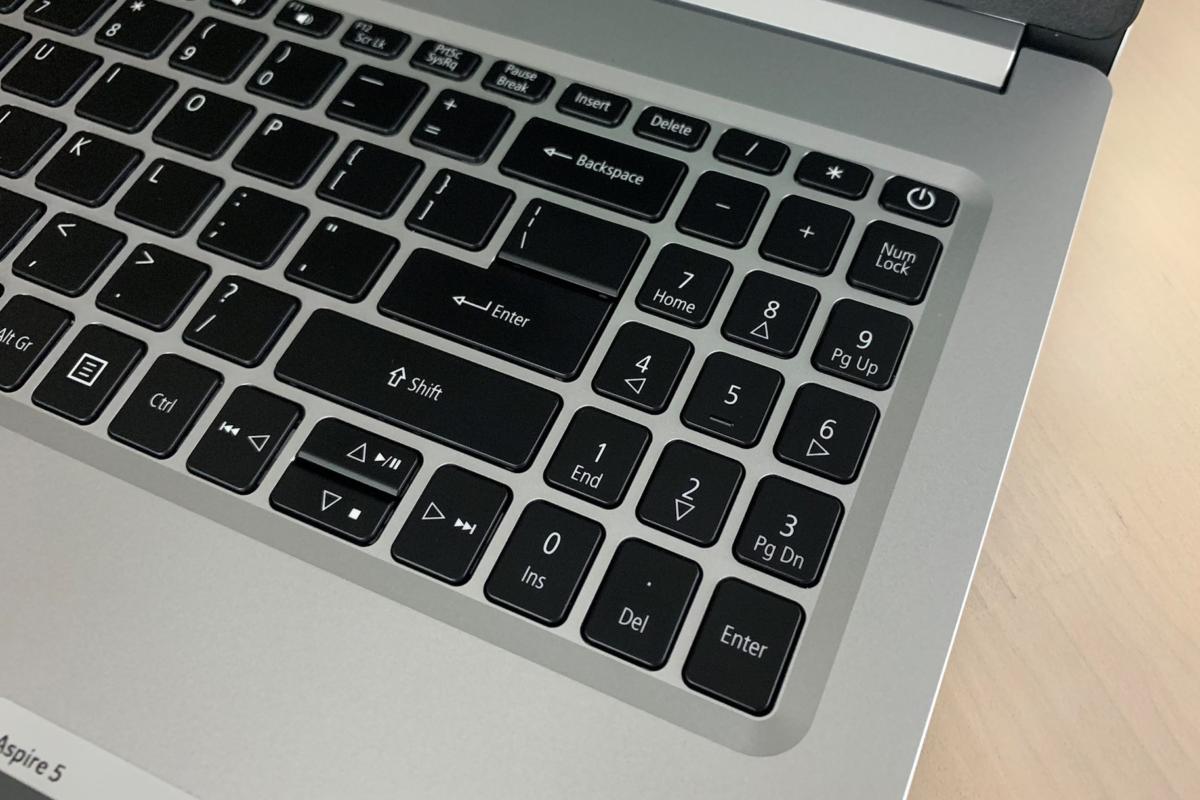
Back on the plus side, the trackpad comes with a fingerprint reader, handy for signing into your Windows profile or any Windows Hello-compatible apps by pressing your fingertip on the sensor. I used the fingerprint reader, which sits in the top-left corner of the trackpad, repeatedly throughout my testing and didn’t have any problems.

Ports
The Aspire 5’s collection of ports offers a decent selection of new and legacy options. On the left side, you’ve got a full-on Gigabit ethernet port for an old-school wired connection to your router. You don’t often see ethernet ports in laptops this thin, but this one has a "dropjaw" spring mechanism so the port can expand to accommodate a cable connector. You also get a couple of speedy USB 3.0 Type-A ports, HDMI, and a USB 3.1 Gen 1 Type-C port for connecting newer USB-C-equipped storage devices and peripherals.
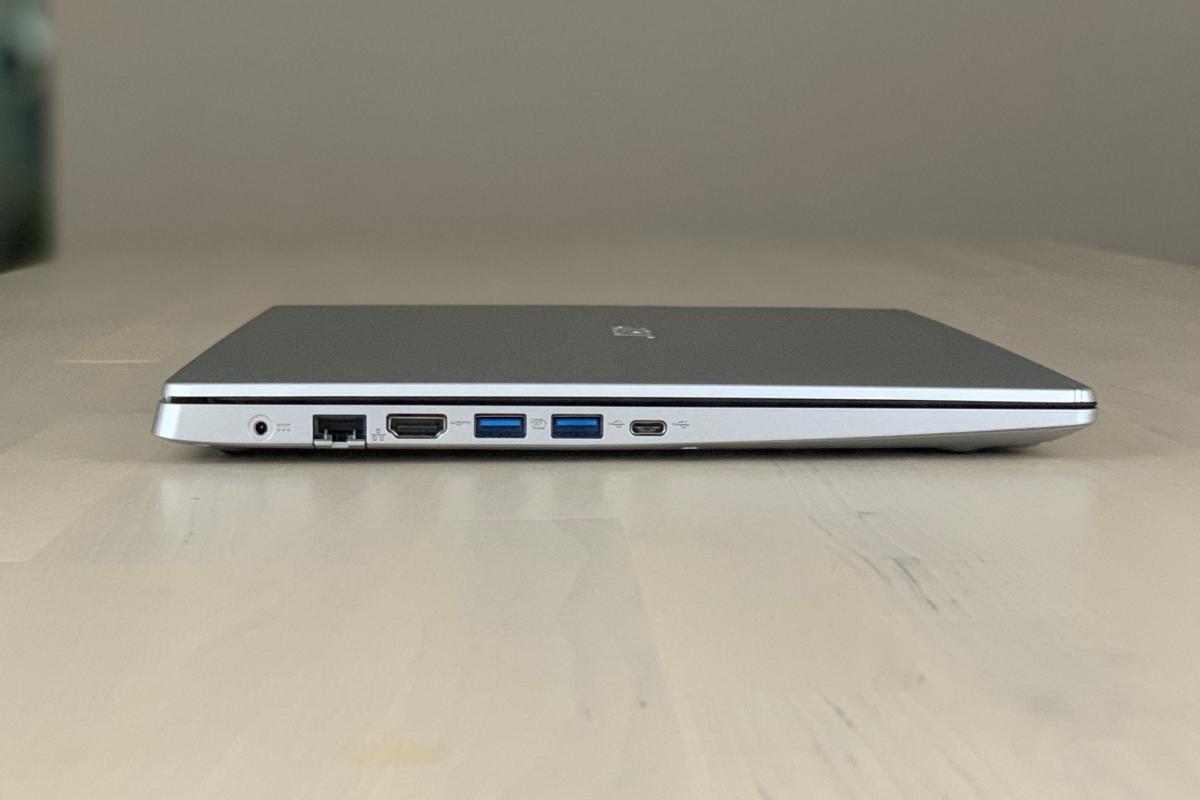
On the left side of the Aspire 5, you'll find a pair of USB 3.0 Type-A ports, along with Gigabit ethernet, HDMI, and a USB 3.1 Gen 1 Type-C port.
On the right, you get a USB 2.0 Type-A port, plus a combo audio jack.
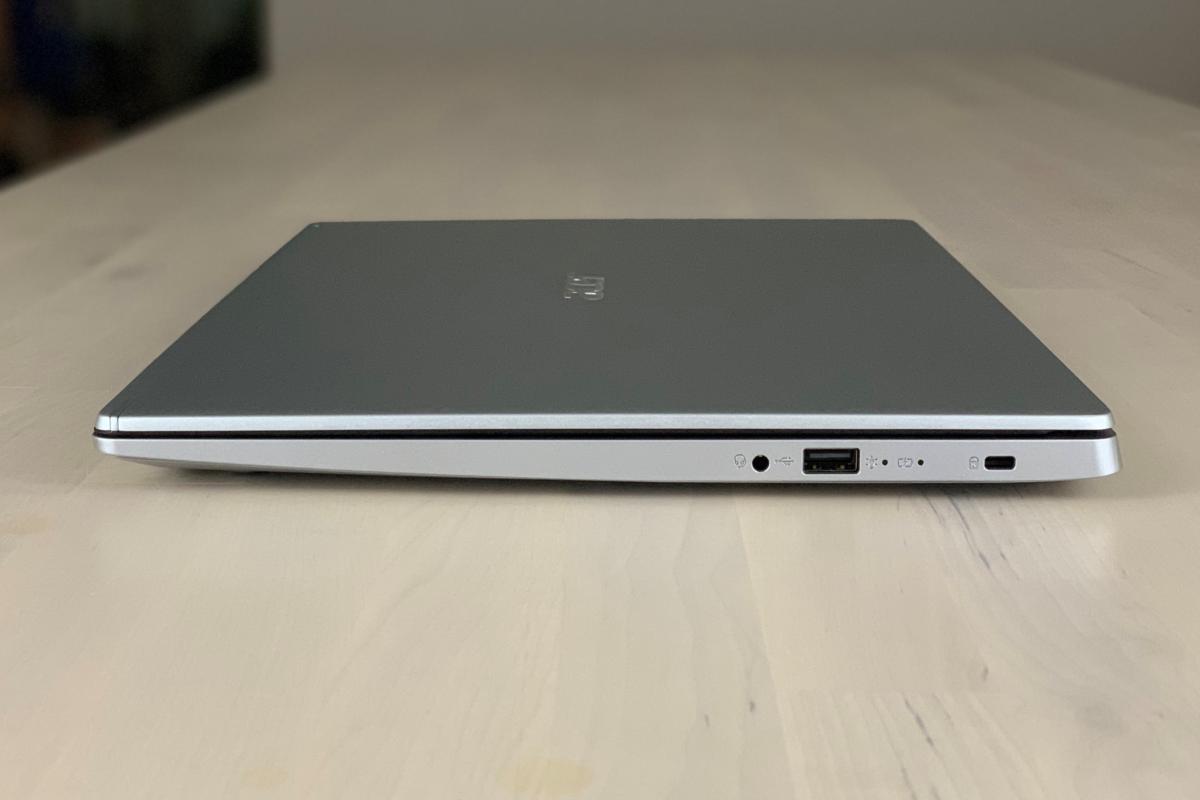
There's a USB 2.0 Type-A port and a combo audio jack on the right side of the Aspire 5, but no memory card reader.
Disappointingly, there’s no memory card reader, which means you won’t be able to pop in memory cards from your Android phone or your digital camera.
Performance
With its middle-of-the-road specs, we were expecting middle-of-the-road performance from this Core i5-equipped version of the Acer Aspire 5, and that’s pretty much what we experienced.
The good news is that the Aspire’s got it where it counts, putting up excellent scores when it comes to everyday productivity—think web browsing, Office productivity, playing tunes, and even some light photo editing. That said, the Aspire’s quad-core processor chugs a bit when it comes to CPU-intensive activities, particularly video encoding.
PCMark 8 Work 2.0 Conventional
The PCMark 8 Work 2.0 benchmark simulates such routine desktop activities as composing text documents, fiddling with spreadsheets, shopping on the web, video conferencing, and other day-to-day activities—in other words, the routine desktop chores that are squarely in the Aspire 5’s wheelhouse. Generally speaking, a score of 2,000 or better on the PCMark 8 benchmark means you can expect smooth Office performance.
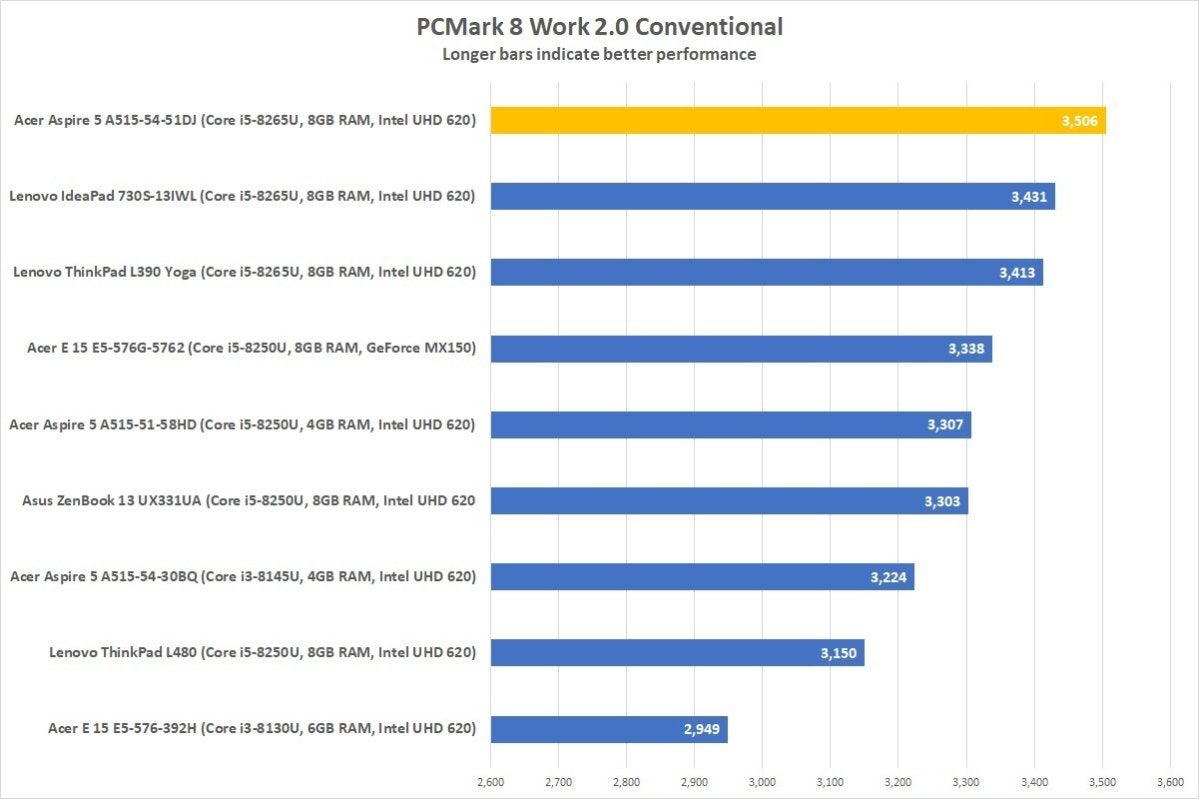
The Core i5-based Acer Aspire 5 gets high marks for its PCMark 8 performance.
The results were impressive, with this particular configuration of the Aspire 5 topping our chart of similar Core i5-powered laptops in roughly the same price range. The Aspire’s PCMark 8 score of a little over 3,500 easily cleared our low-water mark of 2,000 for this benchmark, and it even bests the numbers of competing laptops that cost hundreds of dollars more, although some of those pricier laptops are also much smaller and lighter (and thus tougher to keep cool) than the Aspire.
HandBrake
A considerably tougher test than PCMark 8, our HandBrake benchmark measures how long it takes for a given laptop to convert a 40GB video file into an Android tablet-compatible format. Whereas PCMark 8 is a single-core workout for a CPU, Handbrake demands peak performance from all of a processor’s cores, meaning that the chip with the most cores will generally win out.
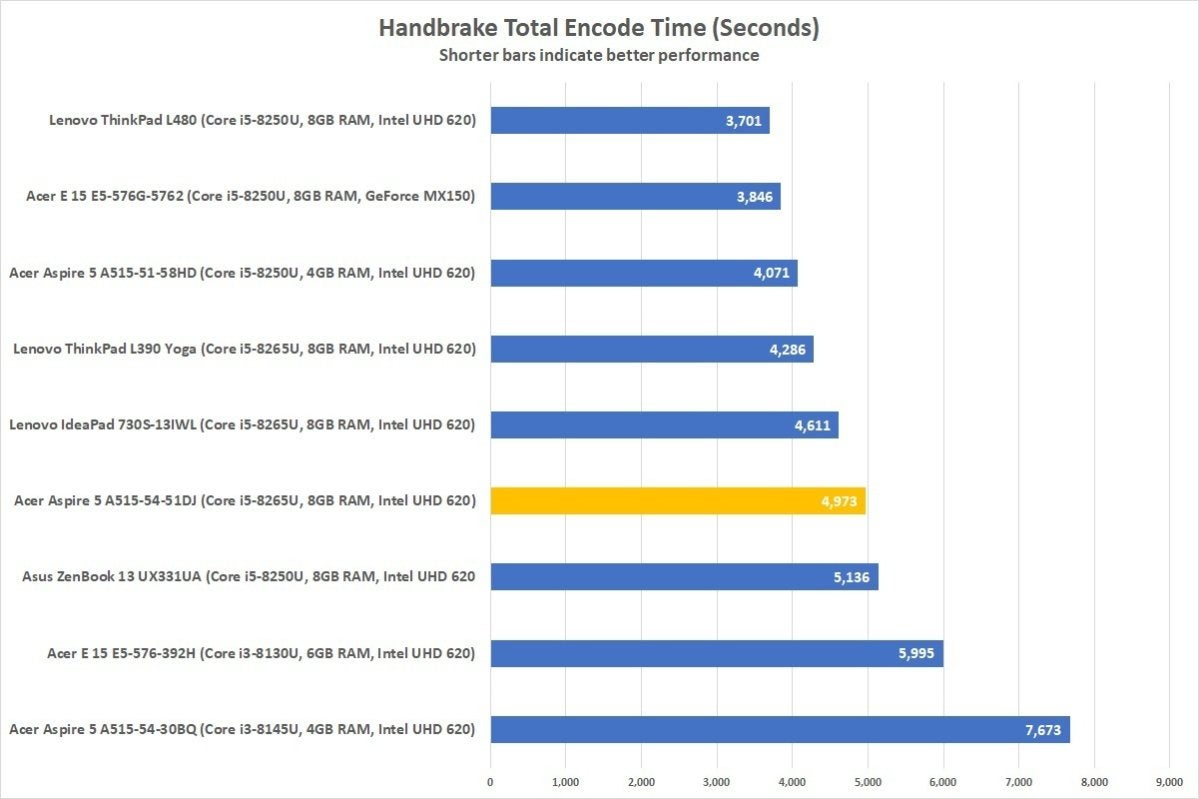
One reason for the Aspire 5's middling Handbrake score is that its quad-core CPU frequently throttles itself to keep things cool.
Like most of the laptops in our comparison chart, the Core i5-powered Aspire 5 has a quad-core processor, and indeed, the Aspire’s 4,973-minute score lands in the ballpark, albeit near the rear of the pack. Ahead of the Aspire are laptops that are either much pricier (like the Lenovo ThinkPad L480) or bigger and therefore easier to cool (like the hefty Acer E 15). Lagging behind the Aspire is the 2.7-pound Asus ZenBook 13. As expected, a couple of dual-core Acer laptops, including a Core- i3-packing version of the Aspire 5 line (full review coming soon), bring up the rear.
Looking under the hood using Intel’s Extreme Tuning Utility, we can see that the Aspire is frequently engaging thermal throttling during the HandBrake test. In other words, it’s repeatedly pumping the brakes on the CPU’s performance to keep it from overheating, most likely a concession to the Aspire’s slim chassis.
The Aspire’s so-so HandBrake score matters only if you have ambitious plans for this laptop. Activities like web browsing and editing Office documents don’t demand multi-core performance; generally speaking, the CPU only needs a single core to handle most mainstream desktop chore. The PCMark 8 benchmark already told us that the Aspire sails right through those types of tasks.
If you’re planning on editing 4K videos, however, then yes, the Aspire 5 may get sluggish as it tries to cool itself off. It'll still get the job done much faster than a dual-core laptop could.
Cinebench
Another benchmark that pushes a CPU to its limits, Cinebench measures how long it takes for a given system to render a 3D image in real time. It’s another multi-core torture test, and again, we should look for laptops with the most processor cores to be topping the chart.
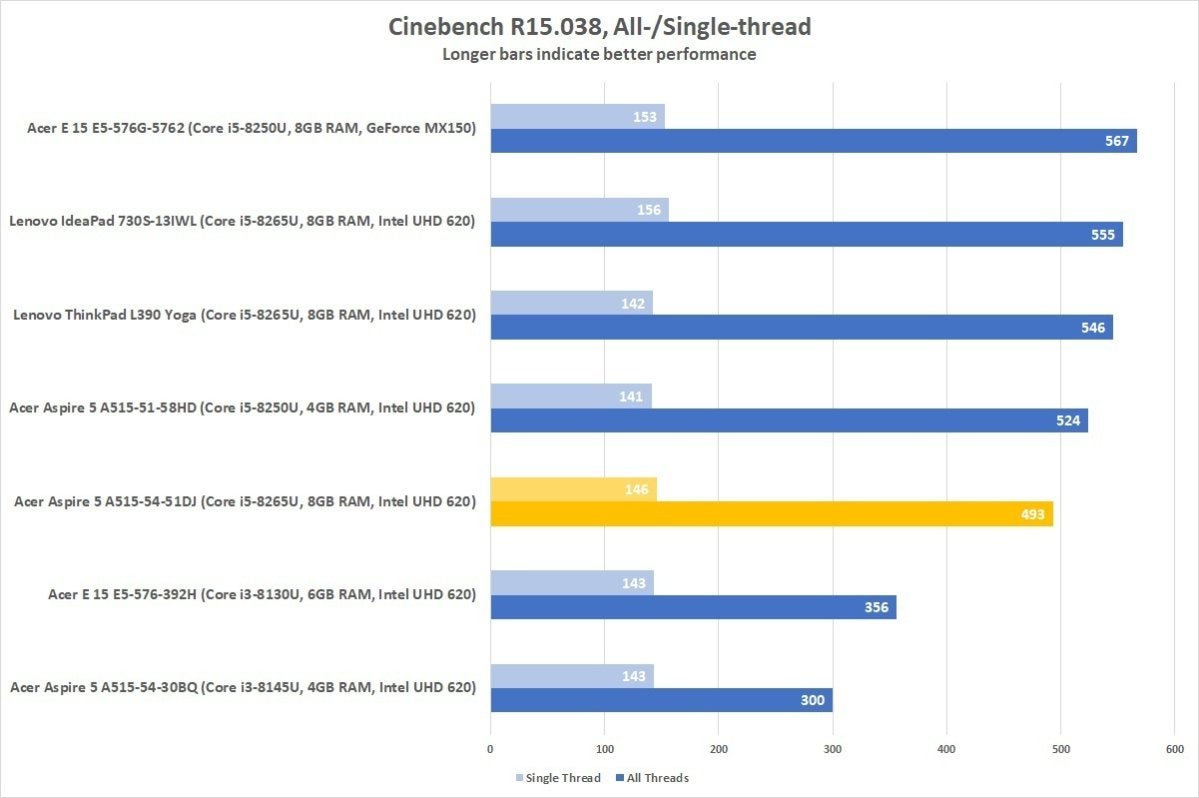
As with Handbrake, the Aspire 5's all-threads Cinebench score is lower than we'd like, although its single-thread score is right where it should be.
Reflecting the results of the HandBrake test, the Core i5-powered Acer Aspire 5 again brings up the rear of the Core i5 pack in the multithread Cinebench test, although it’s by no means a blowout. Indeed, while we (again) saw the Aspire 5 dialing down its CPU via thermal throttling during the test, its 493 all-threads Cinebench score is still relatively respectable.
Also interesting are the single-thread Cinebench test results, which shows the Core i5-powered Aspire 5 basically even with its competition, save for the much heavier Aspire E15 and expensive Lenovo IdeaPad. The Aspire 5’s relatively strong single-threaded performance bodes well when it comes to everyday computing duties.
3DMark Sky Diver
With its integrated Intel UHD Graphics 620 core, it’s unfair to expect much from the Aspire 5 in terms of gaming, but we put it through its paces anyway with the 3DMark Sky Diver graphics benchmark.
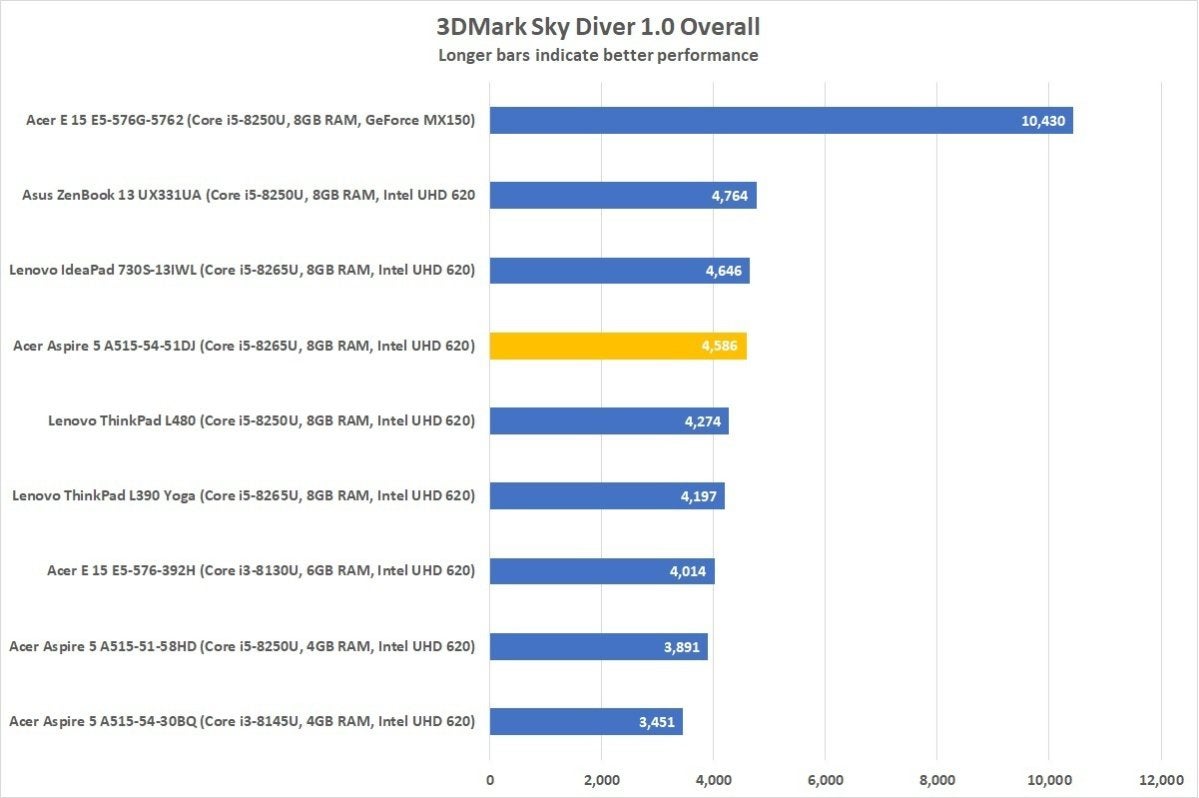
The Aspire 5 and its integrated graphics core sits bunched up with similarly configured laptops, while the Acer E 15 tops the chart thanks to its discrete graphics card.
No surprises here, with the i5-packing Aspire 5 in the top third of its class in our chart. What’s that one laptop at the top that’s blowing all the others away? It’s the Core i5-enabled Acer E 15, a bargain-priced laptop with an ace up its sleeve: a discrete GeForce MX150 graphics card. The MX150 is no powerhouse, mind you, but it illustrates the difference that even an entry-level discrete graphics card can make.
Battery life
We test battery life on laptops by looping a 4K video over and over using the stock Movies & TV playback app for Windows, with the screen brightness tuned as closely as possible to 250 nits (which meant cranking the Aspire’s brightness all the way up) and with the volume set to 50 percent, with headphones plugged in.

With a little more than nine hours of battery life in our testing, the Aspire 5 is perfect for day-tripped without a power adapter.
On average, it took a little over 9 hours for the 49 watt-hour battery in the Core i5-equipped Aspire 5 to die, which is right in line with our expectations. Topping the list is the Asus ZenBook 13, which wrings an exceptional amount of juice out of its similar-sized battery. The Acer E 15 benefits from a larger 62 watt-hour battery. In any event, the Aspire 5’s nine-hour result in our battery rundown trial means close to all-day battery life.
Bottom line
Capable of smooth-as-butter performance for mainstream computing activities, this Core i5-powered version of the Acer Aspire 5 manages to pack quad-core power into a thin, budget-priced chassis. But while it can run Office like a charm, the Aspire’s quad-core performance isn’t quite as impressive, and we’re also disappointed by its dim display.
Note: When you purchase something after clicking links in our articles, we may earn a small commission.
OUR VERDICT
The Acer Aspire 5 is a mid-range laptop that ticks pretty much all the boxes you’d want for a day-to-day laptop: it performs most tasks well, plays media fine and has a very good battery life, all for a compelling price.
FORGood battery life
Up-to-date components
Good build quality
Decent performance
Well priced
AGAINSTCheap-feeling touchpad
Screen isn’t the most vibrant
Not as light and thin as other laptops
Acer Aspire 5 Slim Laptop, 15.6 inches Full HD IPS Display
It’s easy to overlook mid-range machines like the Acer Aspire 5 these days, especially in the shadows of high-end laptops with svelte and light form factors and budget laptops that prove to be capable despite their rock-bottom prices.However, mid-range laptops are, in fact, the laptops that many of us are most likely to buy. Striking a balance between the latest powerful components and affordability, they’re ideal if you want something future-proof that won’t break the bank.
And, with the Acer Aspire 5, Acer may have proven once again that mid-range machines are the way to go. Updated with 8th-generation Intel Core processors, to start, this more than competent laptop ticks all the boxes you’d want for a day-to-day laptop, as long as your computer needs doesn’t include a whole lot of video editing or designing and drafting.
In this review, we take a look at what this affordable laptop can do. With Black Friday just a few days away, it might even be the perfect time to buy it if you think it’s the laptop for you.

The Acer Aspire 5 performs most tasks well.
SPEC SHEET
Here is the Acer Aspire 5 A515-51-50Y5 configuration sent to TechRadar for review:
CPU: 1.60Hz Intel Core i5 8250U (quad-core; 6MB cache; up to 3.40GHz)
Display: 15.6-inch FHD (1,920 x 1,080) LED
Graphics: Intel UHD Graphics 620
Memory: 8GB DDR4 RAM
Storage: 256GB SSD
Connectivity: 802.11ac Wi-Fi; Bluetooth 4.1
Camera: HD Camera
Ports: 2 x USB 2.0, 1 x USB 3.0, 1 x USB 3.1 (USB-C), HDMI, SD card reader, 3.5mm audio jack, Ethernet Dimensions: 15.02 x 10.35 x 0.85 inches (38.16 x 26.3 x 2.16 cm) Weight: 4.85 pounds (2.2kg)
Price and availability
processor, 15.9-inch 1080p display, integrated graphics and 8GB of DDR4 RAM.
In the UK, the lowest-specced Aspire 5 comes with an older Intel i3-6006U processor, 15.6-inch Full HD display and 8GB of RAM, . In Australia, the Aspire 5 A515-51G is the cheapest model, and comes with a new Intel Core i5 8250U processor, 15.6-inch 1366 x 768 display, 8GB RAM and a dedicated GeForce 940MX graphics card.
Beyond these budget options there's a huge range of Acer Aspire 5 configurations to choose from, which again vary depending on where you live, with top-of-the-line models like the Acer Aspire 5 A517-51G-8433 boasting an Intel Core i7 8550U processor, 17.3-inch 1080p screen, 12GB RAM, a HDD and SSD and dedicated graphics courtesy of an Nvidia GeForce MX150 GPU.
The version reviewed here is the Acer Aspire 5 A515-51-50Y5, which comes with an Intel Core i5 8250U, integrated graphics, 8GB DDR4 RAM and 256GB SSD.

It's not as light and thin as other laptops.
Design
The design of the Acer Aspire 5 is what you’d probably expect from a mid-range laptop: nothing too flashy, and not as svelte as ultrabooks such as the Dell XPS 13 or the Asus ZenBook 3. However, that doesn’t mean this is a chunky, ugly laptop. With dimensions of 2.16 x 38.16 x 26.3cm and a weight of 2.20kg (4.85 pounds), the Acer Aspire 5 is quite a large laptop, but it’s not too heavy or unwieldly to carry around. You may find it a bit of a struggle to whip out and work on a busy train, however.
It’s actually quite a nice-looking, understated machine with a few design flourishes. The chassis is mainly made out of plastic, with a textured surface on the lid, along with a reflective Acer logo.

The design of the Acer Aspire 5 is not flashy.
Opening the laptop reveals a decent-sized screen surrounded by fairly thick bezels, which some may feel is wasted space. It does, at least, allow for a large keyboard on the bottom half of the laptop, which we’ll get to in a moment.
The large bezels also mean the webcam can be positioned in the center of the top bezel, which in our opinion is the best place for a webcam to reside.
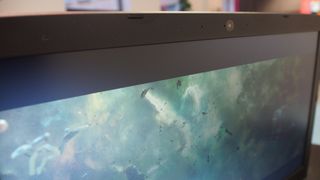
The IPS screen is decent, if a little washed-out.
The bottom bezel holds another Acer logo, and below that is the nicely-designed laptop hinge that has ‘Aspire’ engraved on it – a nice touch, we think. The hinge allows for a decent degree of adjustment of the screen at a range of angles, although this isn’t a laptop on which you can flip the screen 360 degrees backwards, into a tablet-like position – for that you’ll want a convertible laptop, such as Acer’s own Spin 7 series.

The keyboard itself is a nice size, which makes typing on it for long periods comfortable.
The Acer Aspire 5 comes with two USB 2.0 ports, one USB 3.0, a USB-C, Ethernet and SD memory card port, giving you plenty of options for connecting peripherals.

The Acer Aspire 5 comes with two USB 2.0 ports, one USB 3.0, a USB-C, Ethernet and SD memory card port.
We’d have liked maybe one of the USB 2.0 ports to be another USB 3.0, but the USB-C port is definitely a welcome addition that gives you some future-proofing.
Keyboard and touchpad
The bottom half of the laptop, where the large keyboard and touchpad sit, again has a plastic surface, but it has a brushed finish that, while not as premium as aluminum, is still quite pleasant. It didn’t take it too long to pick up fingerprints, however.

The keyboard is not the most responsive or satisfying-feeling.
The keyboard itself is a nice size, which makes typing on it for long periods comfortable, although the flat keys and short travel distance mean it’s not the most responsive, or satisfying-feeling, keyboard we’ve tried.
The large form factor of the Acer Aspire 5 means it can hold a rather large touchpad, which is offset slightly to the left of the center of the chassis.

The touchpad has a rather plastic and cheap feel to it when pushed.
The large size ensures that using multi-finger gestures, such as pinching two fingers together to zoom out, is easy, although some people may find the larger size means they're more likely to accidentally rest their palm on it when typing, sending the curser flying around the screen. The touchpad also has a rather plastic and cheap feel to it when pushed, which is a shame, as the rest of the Aspire 5 manages to avoid that.
Acer bills the Aspire 5 as a laptop for day-to-day tasks, and for the most part it succeeds at these. The solid state drive (SSD) keeps Windows 10 feeling pretty fast, while the 8GB of RAM and quad-core Intel Core i7 8550U processor help with multi-tasking. For general Windows desktop applications, the Aspire 5 does a fine job – it doesn’t feel quite as nippy as more expensive laptops, but for regular use it’s absolutely fine.
As we just mentioned, the SSD in the model we tested helps to keep things running quickly, so if your budget allows we'd recommend going for a model with an SSD installed – and preferably with an additional standard hard drive as well. This is because the 256GB SSD our Aspire 5 came with was already pretty full without us installing much on it – you may find that you need to invest in an external hard drive to make room for your apps and media.

Acer bills the Aspire 5 as a laptop for day-to-day tasks.
The IPS screen is decent, if a little washed-out, with contrast not being quite as strong as we’ve seen on other laptops. However, the Full HD (1920 x 1080) screen is welcome, making movies and photos look a lot better than on laptops with lower resolutions, and Acer has included its Color Intelligence technology, which it claims dynamically adjusts gamma and saturation in real time to make the screen look the best it can.
To be honest, we didn’t see much of a difference, and again for standard day-to-day tasks the screen will be fine, especially with that Full HD resolution; however, if you want to edit photos or videos, you may want to look at an alternative machine.
And if you’re a gamer then you should definitely look elsewhere, as while the integrated Intel 620 UHD graphics will handle photos and videos, and maybe a undemanding indie game or two, for the most part modern games won’t run well on this laptop – although, of course, that’s not what it’s been built for.
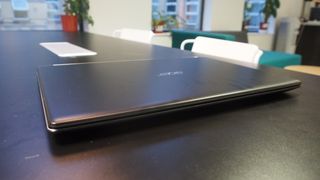
The Acer Aspire 5 lasted six hours and 48 minutes using the PCMark 8 battery test.
Battery life
Battery life was pretty impressive, with the Acer Aspire 5 lasting six hours and 48 minutes using the PCMark 8 battery test, which replicates medium to heavy use. If you dim the display a bit (we had it set to full brightness), and keep to light web-browsing and less strenuous tasks, you could eke out even longer life.
It at least means that you should get through most of a work day on a full charge, which compared to some laptops is really good, and a sign that the more power-efficient processor is paying off. In our own day-to-day use we found that the battery did a good job of letting us work on the Aspire 5 for most of the day.
The battery does take a while to charge, however – specifically three hours to get back to full capacity.
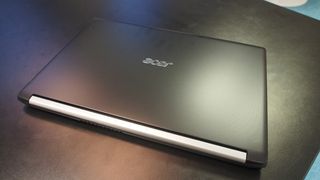
If you’re looking for a mid-range laptop that won’t cost the earth, then the Acer Aspire 5 is a great choice.
We liked
The Acer Aspire 5 has a nice design and good build quality – apart from the slightly loose-feeling touchpad. The large range of ports is welcome, and makes this a versatile laptop for using with a number of peripherals, and battery life is very good. It also remained cool and quiet during our tests.
For the price, you’ll feel like you’ve got your money’s worth with the Aspire 5, including some up-to-date components.
We didn’t like
The touchpad doesn’t feel as satisfying to use as those found on other laptops, and it’s an unfortunate reminder that this is not a premium device.
The screen is also a little washed-out for our tastes, with contrast not as high as we'd have liked.
Final verdict
If you’re looking for a mid-range laptop that won’t cost the earth, but which isn’t compromised with cheap build quality and out-of-date components, then the Acer Aspire 5 is a great choice.
The range of configurations available means there’s a good chance you’ll find an Aspire 5 model that suits your needs and budget – while the model we tested wasn’t too capable when it came to graphical oomph, there are options to get an Aspire 5 with a dedicated graphics card.
Battery life was particularly good, so if you want an inexpensive laptop that can dependably handle day-to-day tasks without needing to be constantly plugged into a power socket, the Aspire 5 is definitely worth considering.
However, if you like your laptops to, well, aspire to something more, such as being able to run modern games or cope with heavy-duty image and video editing, then you’ll need to look elsewhere.
Acer Aspire 5 Slim Laptop, 15.6 inches Full HD IPS Display
amazon affiliate link below














Post a Comment